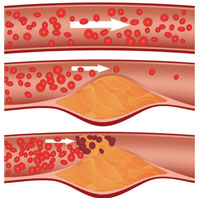According to the Centers for Disease Control and Prevention (CDC), heart disease will claim an estimated 600,000 lives this year, making it America’s number one killer.This year more than 920,000 Americans will have a heart attack; nearly half of them will occur without prior symptoms or warning signs.
What is the link between Heart disease and oral health?
According to Harvard Medical School Health reports Oral bacteria could harm blood vessels or cause blood clots by releasing toxins that resemble proteins found in artery walls or the bloodstream. The immune system’s response to these toxins could harm vessel walls or make blood clot more easily. It is also possible that inflammation in the mouth revs up inflammation throughout the body, including in the arteries, where it can lead to heart attack and stroke.
Oral health can provide warning signs for other diseases , including heart disease:
Heart disease and oral health are linked. There are two different connections between heart disease and your oral health:
- Studies have shown that people with moderate or advanced gum (periodontal) disease are more likely to have heart disease than those with healthy gums.
- Oral health holds clues to overall health. Studies have shown that oral health can provide warning signs for other diseases or conditions, including heart disease.Oral manifestations of systemic diseases are potential indicators of an array of conditions.
Oral cavity is a mirror that reflects many of the human body’s internal secrets.
During my 30 years of practicing dentistry, I have developed the ability of looking at a patient’s dental health and tell, in general, whether the person is healthy overall. I have sent many of my patients, who had no idea about their general health, to a physician and in many cases they have come back and thanked me for saving their lives.
Gum disease can cause heart disease, stroke and diabetes
Because the mouth is a pathway to the body, people who have chronic gum disease are at a higher risk for heart attack, according to the Academy of General Dentistry (AGD). Gum disease (called gingivitis in its early stages and periodontal disease in the late stages) is caused by plaque buildup.
Warning signs for gum disease:
Gum disease may progress painlessly, producing few obvious signs. However, the signs that you may have gum disease include:
- Gums that bleed during and after tooth brushing
- Red, swollen, or tender gums
- Persistent bad breath or bad taste in the mouth
- Receding gums
- Formation of deep pockets between teeth and gums
- Loose or shifting teeth
- Changes in the way teeth fit together upon biting down, or in the fit of partial dentures.
How is gum disease treated?
- Your dentist or dental hygienist will remove the plaque and tartar both above and below your gum line. This procedure, called root planing and scaling, makes it harder for plaque to stick to the teeth.
- Your dentist may give you antibiotics to kill bacteria and stop the infection. They may be put directly on the gums, swallowed as pills or capsules, or inserted into the pockets in your gums.
- You may need surgery if these treatments don’t control the infection or if you already have severe damage to your gums or teeth. Surgery options may include:
- Gingivectomy, which removes and reshapes loose, diseased gum tissue to get rid of the pockets between the teeth and gums where plaque can build up.
- A flap procedure, which cleans the roots of a tooth and repairs bone damage.
- Extraction, to remove loose or severely damaged teeth.
- After surgery, you may need to take antibiotics or other medicines to aid healing and prevent infection.
After treatment, you will need to keep your mouth disease-free by preventing plaque buildup. You will need to brush carefully and thoroughly after all meals and snacks and floss daily. Your dentist will probably prescribe an antibacterial mouthwash.
Your dentist will schedule follow-up appointments regularly for cleaning and to make sure that the disease has not returned
Risk factors for gum disease:
- Smoking. Need another reason to quit smoking? Smoking is one of the most significant risk factors associated with the development of gum disease. Additionally, smoking can lower the chances for successful treatment.
- Hormonal changes in girls/women. These changes can make gums more sensitive and make it easier for gingivitis to develop.
- Diabetes. People with diabetes are at higher risk for developing infections, including gum disease.
- Other illnesses. Diseases like cancer or AIDS and their treatments can also negatively affect the health of gums.
- Medications. There are hundreds of prescription and over the counter medications that can reduce the flow of saliva, which has a protective effect on the mouth. Without enough saliva, the mouth is vulnerable to infections such as gum disease. And some medicines can cause abnormal overgrowth of the gum tissue; this can make it difficult to keep teeth and gums clean.
- Genetic susceptibility. Some people are more prone to severe gum disease than others.
While regular dental exams are necessary to remove tartar and detect early signs of gum disease, oral health begins by properly caring for your teeth and gums at home. Here are some measures you can take to prevent gum disease and keep your teeth for a lifetime:
An ounce of prevention is worth a pound of cure:
- Brush for two to three minutes, at least twice a day, with fluoridated toothpaste. Be sure to brush along the gumline.
- Floss twice a day to remove plaque from places your toothbrush can’t reach. Don’t like to floss? Try a floss holder, which can make it easier to insert floss between teeth.
- Although not a substitute for brushing and flossing, a mouth rinse can reduce plaque up to 20 percent.
- Eat a healthy diet. Starchy and sugary foods increase plaque, and only a healthy diet provides the nutrients necessary (vitamins A and C, in particular) to prevent gum disease.
- Avoid cigarettes and smokeless tobacco, which may contribute to gum disease and oral cancer.
- Be aware that certain medications can also aggravate gum disease, including oral contraceptives, antidepressants and heart medicines.
- Exercise preventive care and schedule regular checkups — the surest way to detect early signs of periodontal disease.
- Have your dentist correct problems, such as faulty fillings, crowded teeth or teeth-grinding.
In dentistry experience and Continuing Education are everything. Dr. Parvin Carter has over 30 years of experience in Practicing General Dentistry and 25 years in Orthodontics. She has thousands of hours of advanced training. In 2000, Academy of General Dentistry awarded Dr. Carter a Certificate of Mastership (MAGD) in General Dentistry. According to the Journal of the Academy of General Dentistry, only 1% of US dentists achieve this high level of advancement. Dr. Carter is a Certified and Preferred Provider of Invisalign. She has successfully treated over 380 patients with Invisalign.
Did you enjoy this blog? if yes would you send it to a friend please?
|








